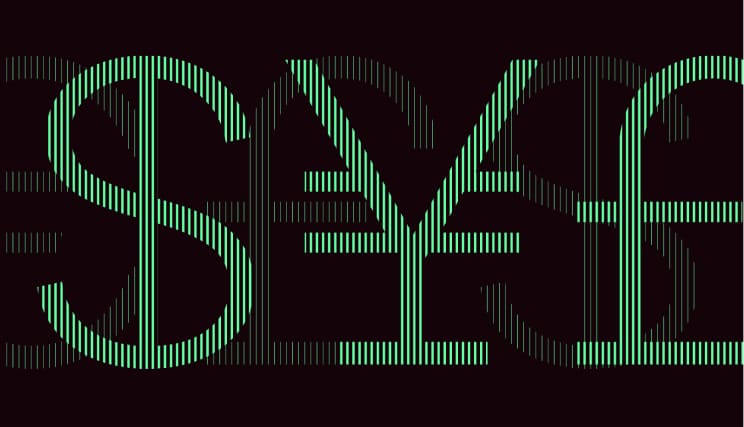Gain an overview of the latest developments on the currency market and anticipate fluctuation risks.
Withstanding the Trump administration
In the end, Donald Trump’s return has not gone hand-in-hand with a stockmarket rally. Quite the opposite. US equities have entered a correction phase. European stocks are proving somewhat resilient. But for how long? In the foreign exchange markets, a massacre is currently taking place in Asia with a plunge in several local currencies, including the Indonesian rupiah and the Indian rupee. No devaluation of the Chinese yuan has materialised to date, but some analysts fear this will happen if the Sino-American trade war intensifies. In this context of high volatility, the euro is resilient. The future is uncertain, however.
EUR/USD
High: 1.0955 Low: 1.0360 Change: +2.69%
In the currency market, the euro continues to be structurally supported by capital inflows into European equities. The performance differential between European and US stocks reached record levels in the first quarter. Be aware, however, that money will start flowing back sooner or later into US equities, which have now become affordable. This could happen as soon as the second quarter, putting downward pressure on the euro. The euro’s resilience should therefore be treated with caution, as it is probably not sustainable. We reiterate our target of 1.0600-1.0650 for the EUR/USD. Note that US monetary policy is likely to remain on stand-by for the time being. The money market estimates the probability of a rate cut in May at just 10%.
EUR/GBP
High: 0.8453 Low: 0.8242 Change: +0.35%
At the end of March, sterling appreciated slightly on the back of the unwinding of long (buy) positions on the EUR/USD. From an economic standpoint, the UK’s situation opens the door to a forthcoming rate cut by the Bank of England. Core inflation reached an annualised 3.53% in February – close to the central bank’s target. The money market puts the probability of a rate cut in May at 80%.
GBP/USD
High: 1.3057 Low: 1.2558 Change: +2.41%
The trend on the pair is upwards. Many institutional investors are worried about the risk of a devaluation of the US dollar by Washington. For the first time since October 2024 – just before the US presidential election – speculators have taken short positions on the US dollar. This is likely to continue as long as the Trump administration’s economic policy remains erratic.
EUR/CNH
High: 7.9187 Low: 7.5582 Change: +3.36%
The Chinese yuan is fairly stable against both the euro and the dollar. Unlike other analysts, we do not think Beijing wants to devalue its currency, even if the trade war intensifies. Its priority is to avoid a capital flight as economic growth picks up. In our view, there will be no currency war between China and the US.
EUR/CHF
High: 0.9680 Low: 0.9333 Change: +1.45%
The Swiss National Bank (SNB) has cut its policy rate by 25bp to 0.25%. In its press release, the SNB underlined the uncertainties weighing on the global economy and, by extension, on Switzerland’s economic outlook. This suggests that forthcoming policy meetings may give rise to unexpected decisions. The Swiss franc’s performance, influenced by risk sentiment in global markets, will continue to have a significant impact on Swiss inflation, particularly for imported goods.
EUR/CAD
High: 1.5858 Low: 1.4918 Change: +2.66%
Watch out if you are exposed to this pair. The US trade war has left the Canadian dollar among the most volatile and weakened currencies. Keep in mind that the Trump administration wants a weaker dollar. Against the Canadian dollar, the greenback is overvalued by 14%, on our calculations. In comparison, the dollar is only 10% overvalued against the euro. Washington can therefore be expected to continue massively targeting Canada.
EUR/AUD
High: 1.7419 Low: 1.6479 Change: +3.38%
No change for this pair. We expect the Reserve bank of Australia to cut its policy rate by 25 basis points in May. This is partly priced into the market exchange rate.
EUR/JPY
High: 164.20 Low: 154.80 Change: +3.98%
The trend is generally upward, despite profit taking from time to time. In monetary policy terms, the Bank of Japan is likely to raise its rates this summer – this is already priced in by the market. During spring wage negotiations, trade unions managed to obtain a raise of close to 5%. This is an additional argument for raising interest rates.
EUR/HUF
High: 407.08 Low: 396.60 Change: +0.14%
In the long term, the Hungarian forint remains highly influenced by the geopolitical backdrop (trade war, negotiations between Russia and the US over Ukraine, European rearmament plan, etc.). In the short term, however, the forint may continue to be aided by the hawkish tone of the central bank, which is rightly concerned about inflationary pressures. No monetary policy change is to be expected for the time being.
USD/HUF
High: 390.84 Low: 362.80 Change: -2.50%
This is a complicated period for the US dollar. It is on a mostly downward trend against the major currencies, but it continues to appreciate against emerging currencies, in particular the Indonesian rupiah (which has plunged) and the forint. Unsurprisingly, risk aversion and uncertainty related to the trade war are bolstering the dollar.
EUR/RON
High: 5.0011 Low: 4.9532 Change: +0.04%
Volatility is present in the short term. But we are maintaining an end-of-year target of 5.05. Overall, Romania’s economic situation is improving in an uncertain global environment. Growth is in an acceleration phase, although it is likely to remain below its potential, as is the case in most European countries bar Spain. The fiscal position remains fragile, but there is nothing new on this subject that might scare away foreign investors. We expect Schengen membership to have some benefits, although these will be more visible 2026. In monetary policy terms, inflation is forecast at around 5% this year. This should allow the central bank to make further rate cuts in the second half of the year.
USD/RON
High: 4.6356 Low: 4.4865 Change: -1.35%
The Romanian currency has shown excellent resilience despite the challenging backdrop amid mounting geopolitical risk. Romania is benefiting from a notable economic upturn and an effective monetary policy – two points that should reassure foreign investors.
Economic Calendar
| DATE | CURRENCY | EVENT |
| 04/04 | USD |
US Employment in March |
| 10/04 | USD | US inflation in March |
| Mid April | EUR |
Reciprocal European tariff measures against the US |
| 29/04 | HUF |
Central bank meeting |
Topics




